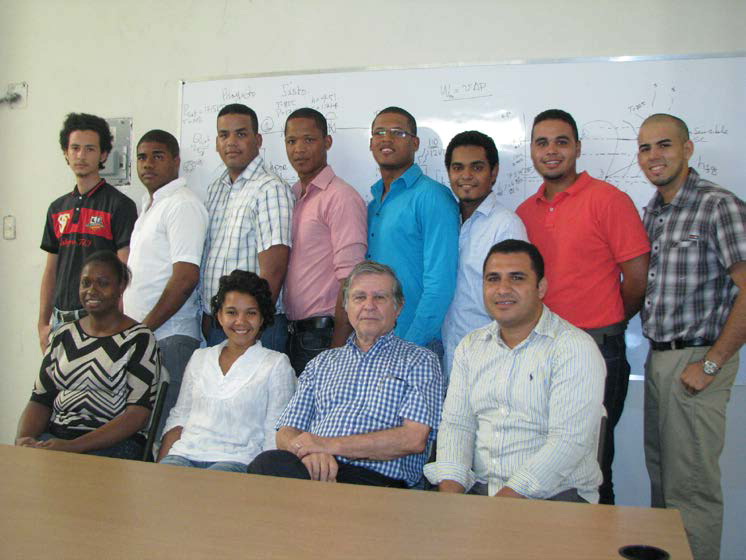|
Cycle 2 (2012 Deadline)
Temperature profile of the ocean seabed from the city of Puerto Plata, Dominican Republic, and preliminary design for a commercial exploitation of cold water to supply for a central air conditioning system PI: Eduardo David Sagredo Robles (Universidad Tecnologica Santiago) U.S. Partner: Naphtali David Rishe (Florida International University)
Project Dates: August 2013 to July 2016 
| | The project team on October 17, 2014. (Photo courtesy Prof. Sagredo) |
Project Overview
Electricity shortages represent one of the major problems facing the Dominican Republic. For more than 50 years, the country has experienced daily electric power blackouts lasting some four to five hours. The cost of electricity in the Dominican Republic is more than 2.5 times the average cost worldwide, which causes financial hardships not only for the general public but also for operators of the large hotels that contribute substantially to the country's economy. Air conditioning uses approximately 60% of the electricity consumed in tourist areas. Given the high cost of electricity and frequent power outages, implementation of a reliable, renewable, and nonpolluting energy source that can supply air conditioning to these hotels would represent the difference between economic survival versus bankruptcy, with its associated severe impacts on local employment.
This PEER project studied a potential site in the city of Puerto Plata for a Sea Water Air Conditioning System (SWAC), which uses pumped seawater to provide cooling through district energy, cooling multiple nearby buildings in a single system.
Final Summary of Project Activities
The PI and his team placed remote sensors at regular intervals along the seabed to gather data to create a seabed temperature profile extending eight kilometers north of Puerto Plata to a depth of 1,000 meters. They also collected sonar seabed floor data along the projected axis for the layout of an extraction pipe. These data collected helped the PI properly design a pipe along the seafloor to the surface at Puerto Plata to provide a cold-water supply for air conditioning. Researchers studied the environmental impacts of the potential system, as well as optimization of the energy needed to pump the seawater.
The PI met with many stakeholders during the course of the project, including the Consorcio Energético Punta Cana Macao (CEPM) and a large hotel complex in Puerto Plata, both of which could be potential clients for the district cooling system, as well as the Office of the Ministry of Economic Planning of the Dominican Republic. The team prepared detailed scientific and engineering reports and drawings of the potential project, as well as undertook an economic analysis of the project. Researchers also held a final workshop on July 22, 2016, to present results and technological and economical needs for the project to stakeholders and potential clients. Alberto Veloz, the ex-Vice-Minister of Energy, of the Ministry of Energy and Mines was the keynote speaker.
The PI also applied for a follow-on grant to the Clean Energy Finance Facility for the Caribbean and Central America (CEFF-CCA), a program under USAID auspices, in order to conduct a more extensive feasibility study. He and his colleagues hope that once the potential economic benefits and return on investment can be more fully documented, it will be possible to create a private corporation and attract the necessary funds to implement their technology in Puerto Plata.
Project website
| 



